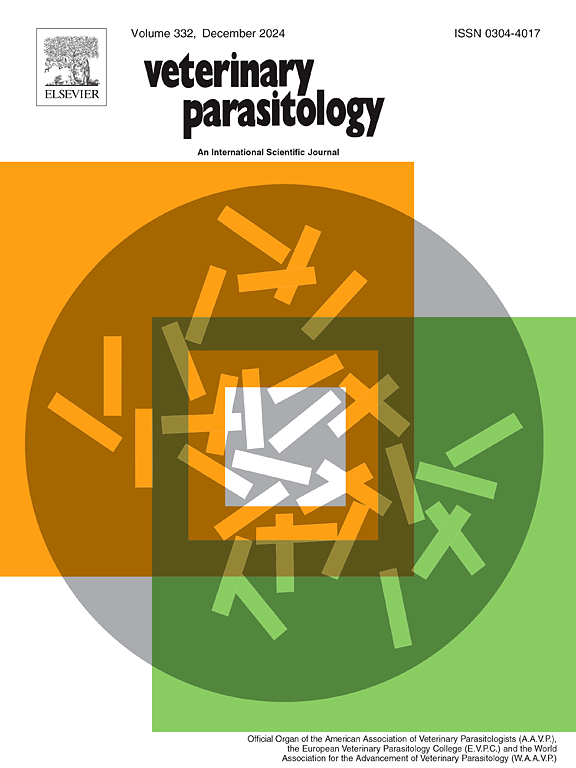首次记录犬类中伏蚊虫群对双甲脒、杀扑磷和氯氰菊酯的剂量反应
IF 2
2区 农林科学
Q2 PARASITOLOGY
引用次数: 0
摘要
Amblyomma cf. parvum(Ixodida: Ixodidae)是美洲大陆家畜和野生动物的一种体外寄生虫。有关杀螨剂对家畜中这种蜱类的控制效果的信息很少。在这里,我们测定了蜱虫对双甲脒、杀扑磷和氯氰菊酯的毒理学反应。我们从墨西哥尤卡坦州的狗身上收集到了噬菌体雌蜱(分两次收集,每次间隔 8 个月)。对成年雌蜱的后代进行了幼虫浸泡试验,以检测对双甲脒的敏感性;对幼虫包装试验进行了检测,以检测对库拉磷和氯氰菊酯的敏感性。剂量-死亡率回归、致死浓度 (LC)、95 % 置信区间 (CI95 %) 和斜率是通过 probit 分析估算的。在第一阶段,双甲脒、高效氯氟氰菊酯和氯氰菊酯杀死50%蜱群的致死浓度分别为1 ppm(CI95 %:1-3 ppm)、10 ppm(CI95 %:9-11 ppm)和10 ppm(CI95 %:9-10 ppm);而在第二阶段,它们的致死浓度分别为2 ppm(CI95 %:1-3 ppm)、8 ppm(CI95 %:6-10 ppm)和9 ppm(CI95 %:8-10 ppm)。总之,在体外生物测定中,双甲脒、高效氯氟氰菊酯和氯氰菊酯对侵扰狗的副猪弧菌种群具有很高的杀幼虫剂效力。本文章由计算机程序翻译,如有差异,请以英文原文为准。
First documentation of dose response of Amblyomma cf. parvum population infesting dogs to amitraz, coumaphos, and cypermethrin
Amblyomma cf. parvum (Ixodida: Ixodidae) is an ectoparasite of domestic animals and wildlife on the American continent. There is little information on the efficacy of acaricides for the control of this tick species in domestic animals. Here, we determined the toxicological response of A. cf. parvum to amitraz, coumaphos, and cypermethrin. Engorged females of A. cf. parvum were collected (in two periods, eight months apart) from dogs in Yucatan, Mexico. The larval immersion test was used on the progeny of adult female ticks to test for amitraz susceptibility, and the larval package test was used to test for coumaphos and cypermethrin susceptibility. Dose–mortality regressions, lethal concentrations (LC), 95 % confidence intervals (CI95 %), and slopes were estimated by probit analysis. The lethal concentrations to kill 50 % of the tick population for amitraz, coumaphos, and cypermethrin in the first period were 1 ppm (CI95 %: 1–3 ppm), 10 ppm (CI95 %: 9–11 ppm), and 10 ppm (CI95 %: 9–10 ppm), respectively; meanwhile in the second period were 2 ppm (CI95 %: 1–3 ppm), 8 ppm (CI95 %: 6–10 ppm), and 9 ppm (CI95 %: 8–10 ppm), respectively. In conclusion, amitraz, coumaphos, and cypermethrin demonstrated high larvicidal efficacy in in vitro bioassays against A. cf. parvum populations infesting dogs.
求助全文
通过发布文献求助,成功后即可免费获取论文全文。
去求助
来源期刊

Veterinary parasitology
农林科学-寄生虫学
CiteScore
5.30
自引率
7.70%
发文量
126
审稿时长
36 days
期刊介绍:
The journal Veterinary Parasitology has an open access mirror journal,Veterinary Parasitology: X, sharing the same aims and scope, editorial team, submission system and rigorous peer review.
This journal is concerned with those aspects of helminthology, protozoology and entomology which are of interest to animal health investigators, veterinary practitioners and others with a special interest in parasitology. Papers of the highest quality dealing with all aspects of disease prevention, pathology, treatment, epidemiology, and control of parasites in all domesticated animals, fall within the scope of the journal. Papers of geographically limited (local) interest which are not of interest to an international audience will not be accepted. Authors who submit papers based on local data will need to indicate why their paper is relevant to a broader readership.
Parasitological studies on laboratory animals fall within the scope of the journal only if they provide a reasonably close model of a disease of domestic animals. Additionally the journal will consider papers relating to wildlife species where they may act as disease reservoirs to domestic animals, or as a zoonotic reservoir. Case studies considered to be unique or of specific interest to the journal, will also be considered on occasions at the Editors'' discretion. Papers dealing exclusively with the taxonomy of parasites do not fall within the scope of the journal.
 求助内容:
求助内容: 应助结果提醒方式:
应助结果提醒方式:


